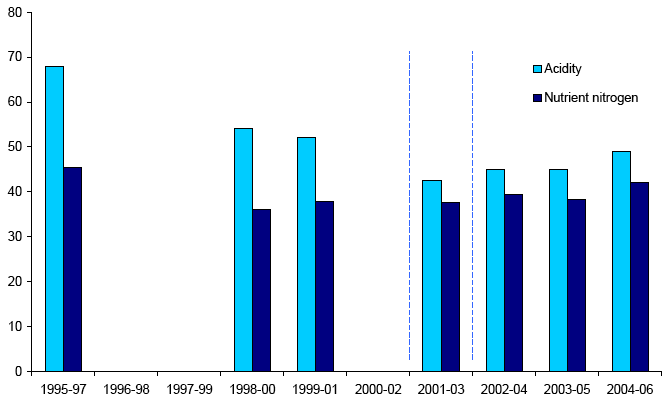Key Scottish Environment Statistics 2009
Annual publication containing summary of key statistics on environmental trends in Scotland
Air Quality
Sensitive habitats affected by air pollution 10: 1995-1997 to 2004-2006
Percentage of sensitive habitat area affected by acid and nutrient nitrogen (N) deposition

Percentage of sensitive habitat area affected by acid and nutrient nitrogen (N) deposition
1995-97 |
1998-00 |
1999-01 |
2001-03 |
2002-04 |
2003-05 |
2004-06 |
|
|---|---|---|---|---|---|---|---|
Acidity |
68 |
54 |
52 |
43 |
45 |
45 |
49 |
Nutrient N |
46 |
36 |
38 |
38 |
40 |
38 |
42 |
Critical loads are thresholds above which the deposition of pollutants causing acidification and eutrophication causes significant harm to the environment. The pollutants come mainly from industry, transport and agriculture.
Around 60% of Scotland's land area contains habitats sensitive to acid deposition and 55% to eutrophication. Scotland experienced a reduction in acidity exceedance from 68% in 1995-1997 to 49% in 2004-2006, primarily due to reductions in sulphur emissions. Also the percentage area of sensitive habitats affected by nutrient nitrogen in Scotland fell from 46% to 42%.
The EU National Emissions Ceiling Directive sets limits for emissions of ammonia, nitrogen oxides, sulphur dioxide and volatile organic compounds ( VOCs) to be achieved by 2010. The Gothenburg Protocol (United Nations Economic Commission for Europe, 1999) also sets ceilings for these emissions. The UK ratified the Protocol in 2005.
Source: Centre for Ecology and Hydrology
There is a problem
Thanks for your feedback